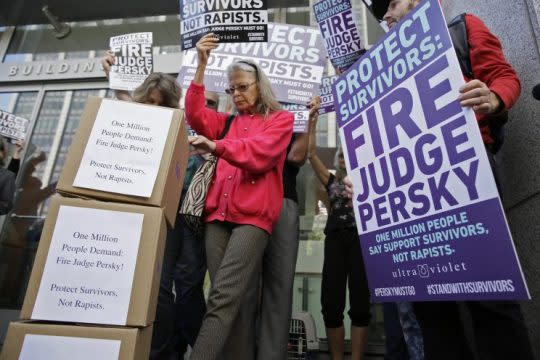Explainer: Why petitions can't unseat Judge Aaron Persky

Hundreds of thousands of people have signed petitions demanding the removal of Judge Aaron Persky and were set to present their signatures to a California state commission Friday, but it is all but impossible that their campaign could lead to his removal.
Outraged observers created the petitions to oust Persky after he handed down what was criticized as a light sentence in the sex assault trial of ex-Stanford swimmer Brock Turner.
Turner was convicted on three felony counts: assault with intent to commit rape of an intoxicated person, sexually penetrating an intoxicated person with a foreign object and sexually penetrating an unconscious person with a foreign object. He was sentenced to six months in county jail (though he will likely be released after three) and three years probation.
The case captured national attention and sparked widespread outrage after Buzzfeed published a statement the victim, a 23-year-old woman whose name has not been released, read to Turner in court.
One of the most popular petitions, “Remove Judge Aaron Persky from the Bench For Decision in Brock Turner rape case,” had collected more than one million signatures as of June 10.
However, more than 800,000 people signed the petition before the language was changed to make clear the petition was a move to trigger impeachment hears, versus an effort that could result in a recall. As of Friday, language on the petition described the document as, “an effort to force Impeachment hearings for Judge Persky By the California Assembly.”
The petition, started by Maria Ruiz of Miami, FL, stated initially that it presented a valid procedure to unseat a judge and included a list of the three ways a California judge can be unseated, one of which is through a recall election.
For those who signed the petition before the change, here’s why it wouldn’t work:
“Change.org has zero legal effect,” said Derek Muller, an associate professor of law at Pepperdine Univeristy. “I’m sure that Change.org petition includes signatories from all over the country, if not all over the world, whereas the only people who are going to be able to sign a petition to recall this judge would be people who are residing in the district where he was elected.”
A recall procedure allows citizens to remove and replace a public official before the end of a term of office – but in this case isn’t feasible, according to Muller. Currently, only 19 states, plus the District of Columbia, allow the recall of state officials – including California, where Persky resides.
Persky, who graduated from Stanford and received a J.D. from UC Berkeley School of Law, wasn’t on the California June 7 primary ballot because he was unopposed and therefore automatically advances to the November ballot. He will wrap up a second six-year term as judge in January 2017 and has been an elected judge in Santa Clara since 2003. He was nominated for his current position of superior judge by former California Gov. Gray Davis who was recalled in 2003.
The recall process
“He can’t be removed between now and November,” Anita Torres, spokeswoman for the Santa Clara County Registrar of Voters, said.
According to the California Elections Code, because Persky has fewer than 6 months left in this term, he cannot be recalled this term. The code also states that a recall can only start after Persky is in office for 90 days. Persky’s next term as superior court judge, provided he isn’t unseated in a write-in campaign (explained below), begins on Jan. 2, 2017. According to Muller, that means the recall effort could only begin in April 2017 at the earliest.
According to Torres, if residents wanted a recall, proponents would first have to submit a notice of intention to the Santa Clara County Registrar of Voters. Torres said her office hasn’t received any such paperwork as of yet.
After a series of filings, servings and reviews, the petitioning may begin. Recall proponents would have to collect 58,634 signatures (20% of the number of votes cast in the last countywide judicial race, in November 2014).
The write-in process
If residents of Santa Clara County are serious about keeping Persky out of the seat, Torres said the most effective course of action would be to start with a write-in candidate, which is a separate process.
“The earliest that he could be removed from his position would be Nov. 8, [2016] if there was a write-in campaign that was successful,” Torres says.
If someone forces a write-in candidate, the candidate considered for the seat must be qualified for that position and submit 600 signatures by Aug. 17. If the signatures are accepted, then that candidate would need to file his or her nomination with the Santa Clara County Registrar of Voters office by Oct. 25. From there, the election would proceed just like any other.
“If he is unopposed again, and his name does not appear on the ballot again, [Persky] will be considered reelected as of the day of the election which is Nov. 8,” said Torres.

